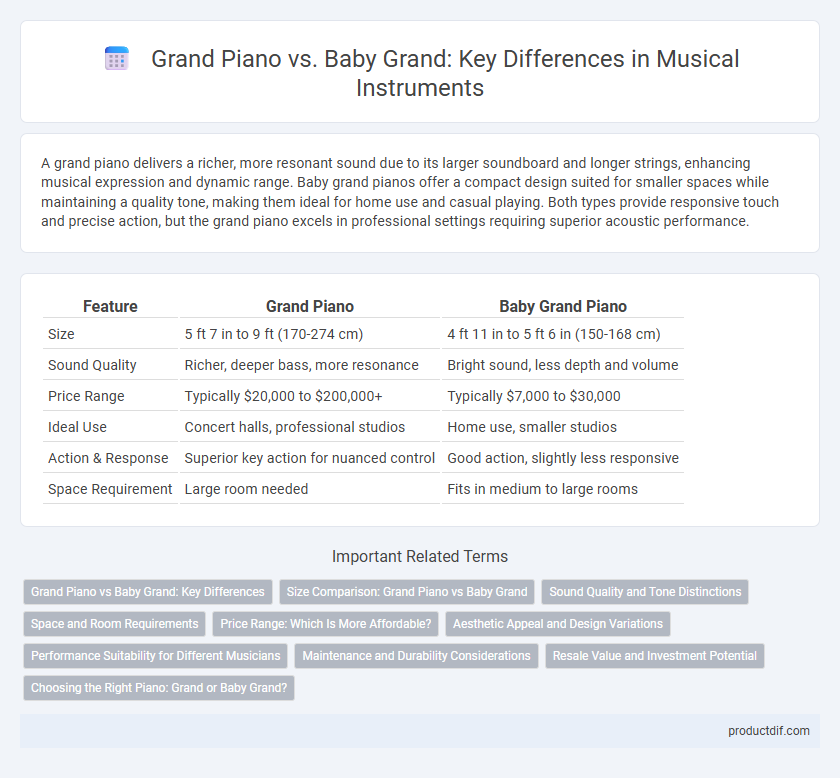A grand piano delivers a richer, more resonant sound due to its larger soundboard and longer strings, enhancing musical expression and dynamic range. Baby grand pianos offer a compact design suited for smaller spaces while maintaining a quality tone, making them ideal for home use and casual playing. Both types provide responsive touch and precise action, but the grand piano excels in professional settings requiring superior acoustic performance.
Table of Comparison
| Feature | Grand Piano | Baby Grand Piano |
|---|---|---|
| Size | 5 ft 7 in to 9 ft (170-274 cm) | 4 ft 11 in to 5 ft 6 in (150-168 cm) |
| Sound Quality | Richer, deeper bass, more resonance | Bright sound, less depth and volume |
| Price Range | Typically $20,000 to $200,000+ | Typically $7,000 to $30,000 |
| Ideal Use | Concert halls, professional studios | Home use, smaller studios |
| Action & Response | Superior key action for nuanced control | Good action, slightly less responsive |
| Space Requirement | Large room needed | Fits in medium to large rooms |
Grand Piano vs Baby Grand: Key Differences
Grand pianos typically measure between 5 to 9 feet in length, offering richer tonal depth and greater dynamic range compared to baby grand pianos, which usually range from 4'5" to 5'6". The larger soundboard and longer strings of a grand piano produce enhanced harmonic resonance, making it ideal for concert performances and professional use. Baby grands, while more compact and suitable for home settings, provide a balanced sound but with less sustain and volume than full-sized grand pianos.
Size Comparison: Grand Piano vs Baby Grand
Grand pianos typically range from 5 to 9 feet in length, offering a larger soundboard and longer strings for richer, more resonant tones compared to baby grand pianos, which usually measure between 4.5 to 5.5 feet. The increased size of a grand piano enhances acoustic projection and tonal depth, making it ideal for concert settings. Baby grand pianos, due to their smaller footprint, suit home environments where space is limited without severely compromising sound quality.
Sound Quality and Tone Distinctions
Grand pianos deliver richer sound quality with fuller tonal depth due to their larger soundboard and longer strings, enhancing resonance and sustain. Baby grand pianos, while more compact, produce a bright, clear tone but with less volume and dynamic range compared to full-sized grands. The tonal distinctions between grand and baby grand pianos impact their suitability for concert performances versus intimate settings.
Space and Room Requirements
Grand pianos require significantly more floor space, with typical lengths ranging from 5 to 9 feet, making them ideal for larger rooms and concert halls. Baby grand pianos, measuring between 4'6" and 5'6", fit more comfortably in smaller spaces such as homes and apartments without compromising sound quality. Choosing between these instruments depends heavily on available room dimensions and acoustic considerations.
Price Range: Which Is More Affordable?
Baby grand pianos typically range from $7,000 to $15,000, making them more affordable for most buyers compared to grand pianos, which can exceed $30,000 depending on brand and craftsmanship. The smaller size and simpler construction of baby grands contribute to their lower price point. Grand pianos often come with premium materials and advanced features, significantly increasing their cost.
Aesthetic Appeal and Design Variations
Grand pianos exhibit a majestic presence with longer strings and larger soundboards, resulting in a visually striking and acoustically rich instrument ideal for concert halls and spacious living rooms. Baby grand pianos offer a compact design with elegant curves, making them a stylish choice for smaller spaces without compromising on the classic grand piano aesthetic. Design variations include different finishes such as polished ebony, satin walnut, and bespoke customizations that enhance both pianos' aesthetic appeal and complement diverse interior decors.
Performance Suitability for Different Musicians
Grand pianos offer superior sound projection and dynamic range, making them ideal for concert pianists and professional musicians requiring expressive performance capabilities. Baby grand pianos suit smaller spaces and offer a balanced tone and touch, perfect for intermediate players and hobbyists seeking quality sound without the spatial demands of larger grands. Both models provide rich acoustic qualities, but the choice depends on the musician's skill level, performance environment, and volume preferences.
Maintenance and Durability Considerations
Grand pianos generally require more frequent tuning and professional maintenance due to their larger size and complex action mechanism compared to baby grand pianos. Baby grand pianos, being smaller, tend to have lower humidity sensitivity and are easier to regulate in home environments, enhancing their durability. Both types benefit from consistent humidity control and regular professional inspections to maintain optimal sound quality and structural integrity.
Resale Value and Investment Potential
Grand pianos generally command higher resale value due to their superior craftsmanship, sound quality, and brand prestige compared to baby grand pianos. Baby grand pianos offer a more affordable entry point but typically experience less appreciation over time, making them a less optimal investment for long-term value retention. Investors often prefer grand pianos from renowned manufacturers such as Steinway & Sons or Bosendorfer for their proven durability and sustained market demand.
Choosing the Right Piano: Grand or Baby Grand?
Choosing the right piano involves evaluating space, budget, and sound preferences, with grand pianos offering superior tonal depth and projection due to their larger soundboards, typically ranging from 6 to 9 feet in length. Baby grands, measuring between 4'6" and 5'6", provide a compact alternative ideal for smaller living spaces while still maintaining rich sound quality and responsive action. Understanding room acoustics and intended use helps determine whether the expansive resonance of a concert grand or the practical elegance of a baby grand best suits a musician's needs.
Grand piano vs Baby grand Infographic

 productdif.com
productdif.com